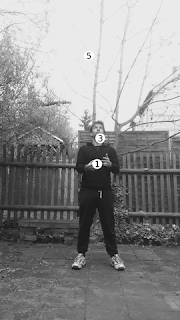I have been a juggler for more than 20 years now. It started when I was thirteen, and primarily interested in doing magic tricks, but I quickly realized that there are more transparent ways of presenting ones manipulation skills. About 15 years ago, when I was starting my studies in Berlin, there was a booming juggling scene in that city, with many young people, including many geeks who studied mathematics, programming, or physics. I, myself, was studying Indo-European linguistics by then, a field deprived of formalisms and formulas, devoted to the implicit as reflected in scientific prose that is not amenable to formalization, modeling, or transparent annotation.
It was at that time that some jugglers began to develop an annotation system for juggling patterns. The system was very simple, using numbers to denote the height and the direction of balls (or other objects) flying around from hand to hand. The 1 denoted the transfer of one ball from hand to hand without tossing it, the 2 denoted to hold one ball in one hand, the 3 to throw it from one hand to the other with a height required to juggle three balls, the 4 to throw one ball up in the air so that one would catch it with the same hand, and the 5 denoted the crossing from one hand to the other, but this time slightly higher, as required when juggling five balls. Some of these numbers are indicated in these animated GIFs.
 |
 |
 |
The people called this system siteswap, and they claimed that it was a good idea to formalize juggling to increase creativity, since one was not required to throw all of the balls with the same number, but one could combine them, following some basic mathematical ideas.
When people told me about this, I was extremely skeptical, probably due to my classical education, which gave me the conviction that juggling is an art, and an art cannot be describe in numbers. When people tried to teach me siteswaps, I ridiculed them, showing them some complicated patterns involving body movements (see the next GIFs), and told them they would never be able to describe all the creativity of all the jugglers in the world in numbers.
 |
 |
 |
Only a couple of years later, I realized that the geeks had proven me wrong, when, after a longer break, I was again participating in one of the many juggling conventions that take place throughout the year, in different locations in Europe and the whole world. I saw people doing tricks with three balls that I had never thought of before, and I asked them what they were doing. They answered, that these were siteswaps, and they were juggling patterns they called 441, or 531, respectively, as shown in these GIFs:
 |
 |
 |
I gave in completely, when I saw how they applied the same logic to routines with five and more balls, which they called 654, 97531, or 744, respectively. Especially the 97531 fascinated me. During this routine, all of the balls end up in one vertical line in the air, for just a moment, but enough even for laymen to see the vertical line, which then immediately breaks down to a normal five-ball pattern, as shown here.

|
 |
 |
Only recently, when I promised colleagues to juggle during a talk on linguistics, I detected the parallel with my own studies in historical linguistics. For a long time, the field has been held back by people claiming that things could not be handled formally, for various reasons.
But I am realizing more and more that this is not true. We just need to start with something, some kind of model, which may not be as ideal and as realistic as we might wish it to be, but that may eventually help us to detect things we did not see before. We just need to start doing it, walking in baby-steps, improving our models and our annotation, as well as improving our understanding of the limits and the chances of a given formalization.
Needless to say, the patterns that I deemed to be un-annotatable 10 years ago in juggling can now easily be handled by my colleagues. They did not stop with the normal number system, but kept (and keep) developing it, and they take a lot of inspiration from this.





